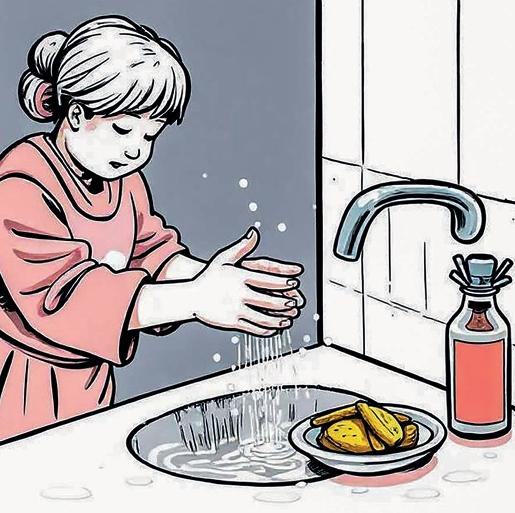The Invisible Enemy in My Bowl
Posted_Date
Image

Body
IT STARTED with a plate of sushi. The delicateslices of raw fish gleamed under the dim lights of a seaside stall, paired with a dab of soya sauce and a curl of ginger. I was at a bustling street market in a small coastal town, the sort where vendors shout over each other and the air hums with life. I didn’t think twice before tucking in. It was delicious – until it wasn’t.
Two weeks later, my skin turned a sickly yellow, my energy drained away like water through a sieve, and I found myself staring at a doctor who said three words that flipped my world upside down: “You have Hepatitis A.”
Hepatitis A Virus (HAV) is one of the most common types of hepatitis viruses that cause liver inflammation and jaundice. This type has been around for a long time – longer than we have been alive, lurking in the shadows of human history. In recent years, its increase has been largely linked to unclean water and food, overcrowding, and poor sanitation, especially concerning toilets. If you think about it, you may have noticed that the number of infectious diseases has increased in recent years. I certainly didn’t – until it hit me personally. My story isn’t just about bad sushi; it’s about how an invisible enemy travel, how it hides in plain sight, and how I fought it off with lessons I’ll never forget.
Hepatitis A spreads mainly through consuming water or food contaminated with the faeces of an infected person. Yes, it’s as grim as it sounds. The virus doesn’t need a handshake or a sneeze – it hitches a ride on something as innocent as a piece of sushi or a sip from a glass. That’s why people are often urged to avoid eating street food that isn’t prepared or cooked hygienically. But it’s not just street food – even in large restaurants, if food isn’t prepared cleanly, it can still pose a risk. My sushi came from a vendor with a weathered wooden stall and a grin, but I didn’t notice the flies buzzing nearby or ask how the fish was washed. I didn’t know then that HAV thrives in places where cleanliness takes a back seat.
Back home, I’d always prided myself on being careful – washing my hands, boiling water when camping, avoiding dubious roadside stalls. But travelling? That’s when my guard slipped.
The town I visited wasn’t dirty by any stretch—just busy, crowded, and alive. Yet, behind the scenes, overcrowding and poor sanitation were brewing a perfect storm. A single infected person, a poorly washed hand, a bucket of unboiled water – it only takes one weak link. And I was the unlucky domino that fell.
When the doctor explained how I’d got sick, I started replaying every bite I’d taken on that trip. Since the spread is reportedly high right now, you should be cautious about these types of food, he warned me:
• Foods that flies have landed on (those buzzing pests around my sushi were a red flag I ignored).
• Foods left uncovered and exposed (the fish sat out, absorbing more than just the salty air).
• Foods that aren’t fully cooked (raw seafood and half-cooked skewers were staples that week).
• Foods handled or prepared without clean hands (who knew where those hands had been?).
• Raw foods like seafood, fruit, or vegetables (my beloved sushi was the smoking gun).
It was astonishing to realize how vulnerable we are to what we eat. I’d always thought of food as fuel, a source of joy – not a po-
tential assassin. But HAV doesn’t care about our love for sushi or our trust in a friendly vendor. It’s a stowaway, sneaking into our
system through the simplest of mistakes. I learned the hard way that flies aren’t just annoying – they’re couriers for a virus that can knock us flat.
The symptoms crept up like a thief in the night. As the name suggests, Hepatitis A causes liver inflammation and jaundice (yellowing of the skin). That was the first clue – my reflection in the mirror started looking like a stranger with a sickly glow. Then came the pale stools and dark urine, a bizarre duo I’d never noticed before. My abdomen ached on the upper right side, where my liver was silently screaming for help. Other symptoms were typical of viral infections: fever that left me shivering under blankets, fatigue that made lifting a spoon feel heroic, muscle aches that turned my body into a battlefield, and a loss of appetite paired with nausea that made food my enemy.
I didn’t connect the dots at first. I thought it was jet lag or a stomach bug from the trip. But when my friends started joking about my “new tan,” I knew something was wrong. The doctor’s diagnosis was a gut punch — not just because I was ill, but because it was preventable. If I’d known what to look for, if I’d been more cautious, I might have dodged this bullet.
Hepatitis A is highly contagious, but it can be easily controlled. It spreads primarily through eating or drinking something contaminated with the virus. If we focus on keeping four things clean – food, water, hands, and toilets – we can prevent this disease. That’s it. Four simple rules I’d broken without realizing.
The science is astonishingly straightforward. At 85°C for just one minute, the virus dies. Boiling water reaches 100°C, so cooking food thoroughly or boiling it already acts as prevention.
If bottled water isn’t available, boil our drinking water – drinking it after boiling is safe. I wish I’d insisted on bottled water that day or checked if the ice in my drink was clean. Wash our hands regularly. Even if we haven’t used the toilet, we could touch something handled by an infected person who didn’t wash their hands, and it could end up in our mouth.
So, wash our hands thoroughly before eating every time. I’d scrubbed my hands before meals at home, but on the road? I got lazy. Big mistake.
To stop the virus from spreading via toilets, make sure ours is fly-proof and clean. Doing this can prevent infection. The guesthouse I stayed at had an open latrine with flies buzzing in and out – another clue I overlooked. Prevention isn’t rocket science; it’s about discipline. And I’d let mine slip.
Since it’s a virus, there’s no definitive cure. Treatment involves plenty of rest, eating a nutritious diet, and using medication to relieve symptoms.
With rest, hydration, and proper nutrition, our immune system can fight off the virus. My doctor sent me home with a prescription for rest – literal bed rest – and a stern warning: avoid alcohol entirely – it can further damage the liver. That part was easy; I didn’t even want to look at a glass of anything.
Recovery was slow. I spent weeks on the sofa, sipping water and nibbling bland crackers while my body waged war. My mum brought me broth, and my friends sent memes to cheer me up, but mostly, I slept. The fatigue was crushing – like someone had unplugged my battery. But little by little, the yellow faded from my skin, my appetite crept back, and the pain in my side dulled to a memory.
Months later, I’m back to normal. My skin’s its usual shade, my energy’s returned, and I can eat sushi again (though I inspect it like a detective now). But Hepatitis A left its mark – not on my liver, which healed, but on my habits. I boil water obsessively when I travel. I wash my hands until they’re raw. I ask vendors questions that make them blink – Where’s your water from? How’s
this prepared? I’ve become that person, and I’m fine with it.
So, here’s my plea: don’t wait for the yellow skin to wake you up. Check your water. Scrub your hands. Cook your food. It’s not glamorous, but it’s powerful.
Because the next time I bite into a piece of sushi, I’ll know I’m the one in control – not the invisible enemy.
Source: The Global New Light of Myanmar


